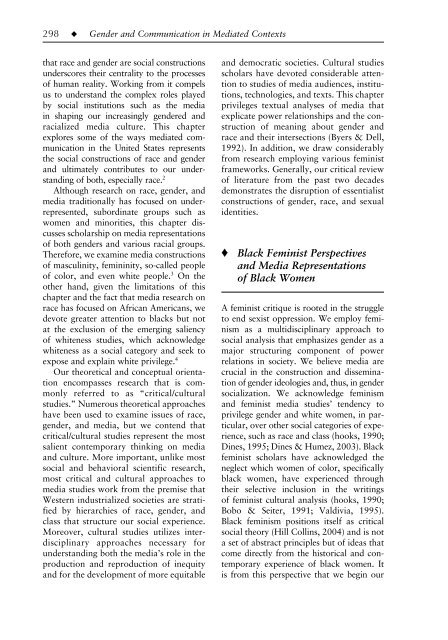Gender, race, and media representation - afghan
Gender, race, and media representation - afghan
Gender, race, and media representation - afghan
Create successful ePaper yourself
Turn your PDF publications into a flip-book with our unique Google optimized e-Paper software.
16-Dow-4973.qxd 6/11/2006 1:42 PM Page 298<br />
298–––◆–––<strong>Gender</strong> <strong>and</strong> Communication in Mediated Contexts<br />
that <strong>race</strong> <strong>and</strong> gender are social constructions<br />
underscores their centrality to the processes<br />
of human reality. Working from it compels<br />
us to underst<strong>and</strong> the complex roles played<br />
by social institutions such as the <strong>media</strong><br />
in shaping our increasingly gendered <strong>and</strong><br />
racialized <strong>media</strong> culture. This chapter<br />
explores some of the ways <strong>media</strong>ted communication<br />
in the United States represents<br />
the social constructions of <strong>race</strong> <strong>and</strong> gender<br />
<strong>and</strong> ultimately contributes to our underst<strong>and</strong>ing<br />
of both, especially <strong>race</strong>. 2<br />
Although research on <strong>race</strong>, gender, <strong>and</strong><br />
<strong>media</strong> traditionally has focused on underrepresented,<br />
subordinate groups such as<br />
women <strong>and</strong> minorities, this chapter discusses<br />
scholarship on <strong>media</strong> <strong>representation</strong>s<br />
of both genders <strong>and</strong> various racial groups.<br />
Therefore, we examine <strong>media</strong> constructions<br />
of masculinity, femininity, so-called people<br />
of color, <strong>and</strong> even white people. 3 On the<br />
other h<strong>and</strong>, given the limitations of this<br />
chapter <strong>and</strong> the fact that <strong>media</strong> research on<br />
<strong>race</strong> has focused on African Americans, we<br />
devote greater attention to blacks but not<br />
at the exclusion of the emerging saliency<br />
of whiteness studies, which acknowledge<br />
whiteness as a social category <strong>and</strong> seek to<br />
expose <strong>and</strong> explain white privilege. 4<br />
Our theoretical <strong>and</strong> conceptual orientation<br />
encompasses research that is commonly<br />
referred to as “critical/cultural<br />
studies.” Numerous theoretical approaches<br />
have been used to examine issues of <strong>race</strong>,<br />
gender, <strong>and</strong> <strong>media</strong>, but we contend that<br />
critical/cultural studies represent the most<br />
salient contemporary thinking on <strong>media</strong><br />
<strong>and</strong> culture. More important, unlike most<br />
social <strong>and</strong> behavioral scientific research,<br />
most critical <strong>and</strong> cultural approaches to<br />
<strong>media</strong> studies work from the premise that<br />
Western industrialized societies are stratified<br />
by hierarchies of <strong>race</strong>, gender, <strong>and</strong><br />
class that structure our social experience.<br />
Moreover, cultural studies utilizes interdisciplinary<br />
approaches necessary for<br />
underst<strong>and</strong>ing both the <strong>media</strong>’s role in the<br />
production <strong>and</strong> reproduction of inequity<br />
<strong>and</strong> for the development of more equitable<br />
<strong>and</strong> democratic societies. Cultural studies<br />
scholars have devoted considerable attention<br />
to studies of <strong>media</strong> audiences, institutions,<br />
technologies, <strong>and</strong> texts. This chapter<br />
privileges textual analyses of <strong>media</strong> that<br />
explicate power relationships <strong>and</strong> the construction<br />
of meaning about gender <strong>and</strong><br />
<strong>race</strong> <strong>and</strong> their intersections (Byers & Dell,<br />
1992). In addition, we draw considerably<br />
from research employing various feminist<br />
frameworks. Generally, our critical review<br />
of literature from the past two decades<br />
demonstrates the disruption of essentialist<br />
constructions of gender, <strong>race</strong>, <strong>and</strong> sexual<br />
identities.<br />
♦ Black Feminist Perspectives<br />
<strong>and</strong> Media Representations<br />
of Black Women<br />
A feminist critique is rooted in the struggle<br />
to end sexist oppression. We employ feminism<br />
as a multidisciplinary approach to<br />
social analysis that emphasizes gender as a<br />
major structuring component of power<br />
relations in society. We believe <strong>media</strong> are<br />
crucial in the construction <strong>and</strong> dissemination<br />
of gender ideologies <strong>and</strong>, thus, in gender<br />
socialization. We acknowledge feminism<br />
<strong>and</strong> feminist <strong>media</strong> studies’ tendency to<br />
privilege gender <strong>and</strong> white women, in particular,<br />
over other social categories of experience,<br />
such as <strong>race</strong> <strong>and</strong> class (hooks, 1990;<br />
Dines, 1995; Dines & Humez, 2003). Black<br />
feminist scholars have acknowledged the<br />
neglect which women of color, specifically<br />
black women, have experienced through<br />
their selective inclusion in the writings<br />
of feminist cultural analysis (hooks, 1990;<br />
Bobo & Seiter, 1991; Valdivia, 1995).<br />
Black feminism positions itself as critical<br />
social theory (Hill Collins, 2004) <strong>and</strong> is not<br />
a set of abstract principles but of ideas that<br />
come directly from the historical <strong>and</strong> contemporary<br />
experience of black women. It<br />
is from this perspective that we begin our




